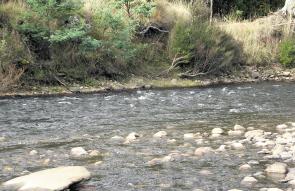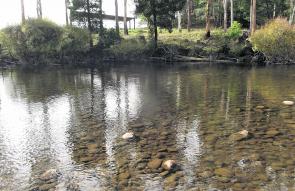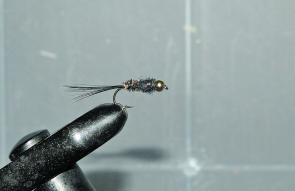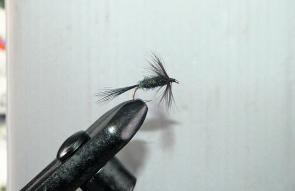It is that time of year we are contemplating our upcoming adventures in the next stream trout season.
Often there is a lot of water in both rivers and lakes early in the season, and with this in mind, we usually also think about our first wade in the water; wading safety is very important. Here are some safety hints and tips to hopefully help keep you out of trouble this season.
The first thing I recommend to all wading anglers and my clients is to wear good quality polaroids, these will cut out surface glare and give you a much better view of the bottom in most conditions, especially those involving reasonably clear water. This helps to see where you are walking and where objects and slippery hazards may be.
I always offer my clients a wading staff, this will often act as a third leg, a point of balance, and a depth tester all in one, this is one of the best safety devices you can use whilst wading. These often have a simple lanyard attached to them so they can be dropped while fishing.
If you have breathable waders, make sure you purchase a good quality boot that is suited to the wading terrain, and fits well, with plenty of ankle support. I prefer felt soles, this gives you good grip for slippery and rocky bottoms, whilst also being quite fine for most lake floors as well. Just bear in mind that felt soles aren’t allowed in New Zealand if you ever venture there). Another essential is a good tight wading belt, this will help slow water from rushing in quickly to your legs should you happen to fall or slip under.
My number one safety rule is to always fish with a friend, there is safety in numbers and to get in trouble alone is a massive risk to take with your life, no fish is worth that.
The rivers early in the season are usually quite full of water and running hard, if you don’t know the river or are unsure of the depth, don’t get in. I’ve built up a knowledge of a lot of my local streams and know all the good crossing points and wadable stretches, but rivers can change, floods and high water can change the depths from one season to the next, and even the best can be left scratching their heads at where to get in.
If you see a good section that is shallow enough to wade, always enter carefully and shuffle with small steps, it will give you a better chance of detecting a quick change in depth and avoiding a fall.
When crossing the large fast flowing stony bottom rivers in my local area, I always avoid the narrow and fast inflows and outflows of pools, this concentrates all the river’s power into a small channel or neck and will often have the power to take you off your feet, always look further above or below for a widening of the river and a much slower current.
When you decide to cross, take your wading staff and dig the end in front, and up current from your body, then shuffle across using the staff as the centre pivot, repeat the process with the staff and slow shuffle until you reach the other side or where you want to begin casting from.
If the current makes it too hard to plant the staff, look for another crossing, If it’s too swift to plant the staff then it’s most likely too swift to plant your feet! If you need to turn around mid-river, don’t turn around upstream, turn by facing down and across and go with the current, not against it. If you happen to fall, which I have a few times, don’t struggle, stay calm and try and float feet up with the current until you can attempt to find your feet again.
If you had a wading belt fastened, you shouldn’t take on a dangerous amount of water, provided you don’t take too long to get to your feet again.
Similar principles apply to lake wading, minus the flow issues. Always scan the bottom and plan your wading route before getting in, remember to shuffle slowly and not take big steps as the depth may change quickly. If you are unsure of the depth or don’t know the water, use a staff to test the depth in front of you. Avoid boggy and silty bottoms that suck your boots down, this is not only unsafe and a falling hazard, but also a poor environmental practise especially in our natural lakes for destroying weed and other living things on the bottom.
Towards summer, when levels subside, rivers and lakes often clear up and become easier to wade and a very pleasant way to cool down, but until then, please be safe and use good safe wading practises like these. Wading can often take you to better fishing and is underrated; I hope it takes you to that magic spot in the new season!
Simple flies are what work best, just a simple starter kit, hooks, and some basic and cheap materials are all that’s needed. Here are some very basic patterns you can start tying this July. It’s a great way to fill in an otherwise uninspiring month of the year for us trout addicts who face closed seasons, or preferring to say inside in the bitterly cold month of July.
Hook: 6-10 Long shank lure style
Bead: 5/32″ or 4mm bead, tungsten for deep water, or Brite bead for medium to shallow.
Thread: Black Uni 06
Hackle: Black or dark coloured bugger hackle
Tail: Black or brown Marabou
Body: Black, Olive or any coloured spirit River Diamond Brite Dubbing of your choice to suit water clarity.
The Diamond Brite fly is a fantastic all round wet fly on rivers, or Lakes. In Rivers I like to fish it straight up and down or dead drift under an indicator in fast streams, or by swinging it across stream like a lure, for slow flowing streams just slow it down.
For Lakes early season it is best fished deep and slow on sinking lines, but a great amount of my friends that I tie for, love to fish this weighted Fly early season in the weedy shallow waters of penstock lagoon with great success on floating lines.
Hook: Kamasan Sub surface, size 10-14
Bead: 1/8″ or 3.2MM Tungsten or brite bead for shallower water
Thread: Black Uni thread 06
Tail: Black hackle fibres
Body/thorax/head: Peacock herl (can be substituted with peacock coloured dubbing)
This is as simple as a nymph can get, and over the years it has produced fish after fish in streams and lakes for me. Fish it upstream under an indicator in rivers. Although it is dark, I believe the glint of the peacock herl and the fibres pulsating and flaring under water really brings the fly to life.
The Peacock wet fly is the same as the Peacock Nymph except you make the body an even tubular size rather than tapering it up as you would a nymph, and leave room at the front to add a few light turns of wet fly (hen) hackle. I love using this fly unweighted to tailing trout, but it can also be weighted and fished in deep water in a team of flies or singular, swung across rivers effectively using a heavier tungsten bead, or fished traditionally upstream, as it makes a great snail pattern.
Reads: 2547
Using the wading staff to help with wading stability – keep it out in front – if the current is too strong to bed it in then it is too strong to wade!

This stretch is probably flowing too fast to cross – look for somewhere with lighter flow.

This is a much better spot to cross – and you might even catch a fish at the same time.

The Diamond Brite Bugger.

The Peacock Nymph.

The Peacock Wet Fly.




